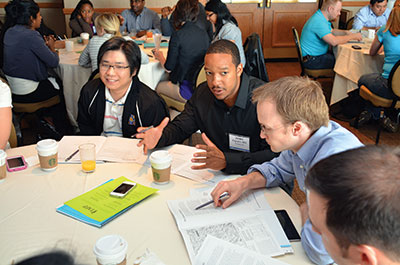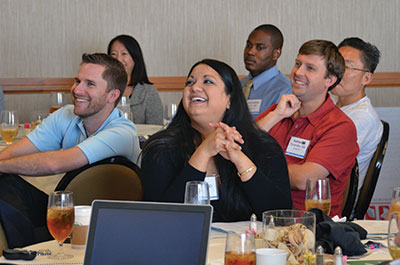Family medicine chief residents hone leadership and management skills at Dallas conference
Family medicine chief residents hone leadership and management skills at Dallas conference


Fifty chief residents from around the state and country gathered for the 2012 Family Medicine Chief Resident Conference in Dallas, Texas, to participate in lectures, panel discussions, and hands-on activities to identify the tasks they’ll face in their upcoming year as chief resident, set goals, and hone their skills to meet the challenges ahead.
It all began Friday morning with speaker Cindy Passmore, M.A., executive director of the UNTHSC Faculty Development Center, leading a discussion on the basic job description of a chief resident. The residents in attendance, in small groups, identified scheduling and conflict resolution as their top two responsibilities. They then set goals for themselves: to improve communication among all residents, organize schedules in advance, and work to improve the quality of life for residents, among others.
“What I liked best about the conference was being able to bounce ideas and concerns off fellow chiefs, and learning more about myself as a leader—both strengths and weaknesses—and how to use those qualities to lead,” said Shane Stone, M.D., chief resident at the Conroe Family Medicine Residency Program.
Passmore also discussed effective observation and feedback, encouraging the chiefs to gather specific information while withholding judgment, use it to pinpoint the source of a problem, and then present it to the recipient providing fair evaluation.
Friday afternoon featured Richard Grant Jr., Ph.D., on enhancing communication with colleagues using the Myers-Briggs Type Indicator. Residents completed the MBTI survey and scored their results, and Grant explained how different types—extraversion vs. introversion, sensing vs. intuition, thinking vs. feeling, and judging vs. perceiving—affect an individual’s preference for communication, problem-solving, and structure, and that pairing opposites can often achieve better results. For instance, “if you put an S, sensing type, together with an N, intuition, you get faster and better problem-solving,” Grant said.
He also put it in the context of recognizing personality types and using them to be an effective manager. “With an F-type, if you’re not a living, breathing example of everything that you say, you lose credibility. T-types don’t care as long as you have the facts,” Grant said. “That’s why being a chief resident is a tough job because you have to be both a T and F. You don’t know which type you’re dealing with.”
Saturday brought a panel of experts to delve deeper into leadership and management skills when faced with real-life situations. The experts included Jackson Griggs, M.D., former chief resident and current faculty at the Waco Family Medicine Residency Program; Jonathan MacClements, M.D., former chief resident, current chair of family medicine, and current residency program director at the University of Texas Health Science Center at Tyler; and Jim Tysinger, Ph.D., vice-chair of professional development in the Department of Family and Community Medicine at the University of Texas Health Science Center at San Antonio. They were joined later in the day by Paty Lesczynski, M.D., former chief resident and current family physician in Allen.
One focus was on conflict and how to manage a disgruntled resident. Griggs identified two types of individuals: one who is deeply conscientious and wants the program to be better and another who may have deep-seated personal issues. “The solution is to listen deeply, try to incorporate their input, and get their buy-in. That can change their attitude. Or if it’s actually malicious, sequester them.”
MacClements added in the case of a troubled resident, “If they have problems with you, you’re probably not the only one. There’s probably an intervention that should be done.”
When working toward a solution, Tysinger advised the residents, “If someone has an idea, respectfully listen and don’t shut the door. People should be valued as a member of the group; they deserve respect and they deserve to be heard. You want to listen respectfully even though they may seem to be the ‘squeaky wheel.’ They just may be the one with relevant experience and a great solution.”
TAFP presented the 2012 Chief Resident Conference in collaboration with the UNTHSC Faculty Development Center in Fort Worth. Funding for the Faculty Development Center in Waco was zeroed out by the 82nd Texas Legislature and the center closed in August 2011. The TAFP Board of Directors, recognizing the importance of providing training for these future family medicine leaders, agreed to host the 2012 conference. Since then, the University of North Texas Health Science Center has added the new UNTHSC Faculty Development Center to the Office of Educational Programs and the UNTHSC FDC will continue to offer quality programs, including the 2013 Family Medicine Chief Resident Conference.
Passmore says the conference is important to Texas family physicians, TAFP members, academic family medicine, and all Texans because of the vital role these talented young physicians hold in producing a well-trained family medicine physician workforce. “It is no surprise to me that many of the men and women who take part in the Chief Resident Conference go on to assume leadership roles in academic medicine, clinical medicine, their communities, and professional organizations such as TAFP.”